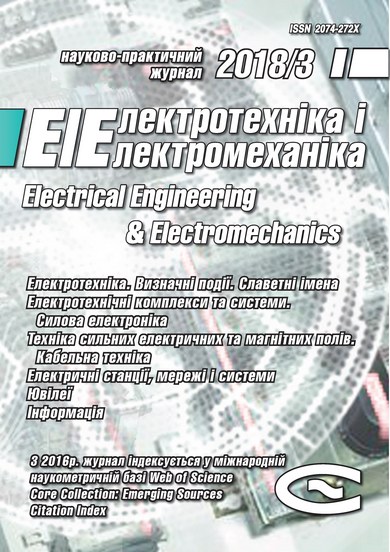ENERGY EFFICIENCY OF THE DISINFECTION TREATMENT OF LIQUID FOODSTUFFS BY HIGH-VOLTAGE PULSE EFFECTS
DOI:
https://doi.org/10.20998/2074-272X.2018.3.07Keywords:
generator of high-voltage pulses, transformer, capacitor, multi-gap discharger, multichannel switch, working chamber, disinfecting food treatmentAbstract
Purpose. Experimentally determine the rational modes and energy efficiency of decontamination treatment of flowing food products using high-voltage impulse actions in comparison with traditional pasteurization. Methodology. We used pulse generation method with the help of a step-up transformer, high-voltage pulse capacitors and spark gaps with a system of peaking of pulse front to obtain high-voltage pulses in working chambers - the generator load. The pulses on the load were measured by a low-resistance resistive voltage divider, were transmitted over a broadband coaxial cable and recorded using an analog C8-12 oscilloscope or a Rigol DS1102E digital oscilloscope with a bandwidth of 100 MHz for each. The working chambers were filled with water, milk or milk whey and consisted of an annular hull made of PTFE and metal electrodes forming the bottom and the chamber cover having flat linings of food grade stainless steel for contact with the food product inside the chamber. Results. We obtained high-voltage pulses on the generator load with a base duration of 300 to 1200 ns at pulse repetition rates up to 500 pulses per second. We obtained experimentally the amplitude of the voltage pulses on the generator load up to 75 kV, and the electric field strength up to 35 kV/cm in working chambers with a gap of 22 mm and up to 50 kV/cm in working chambers with a gap of 15 mm. These characteristics of the pulses allowed complete and irreversible inactivation of microorganisms in food liquids in working chambers. Originality. We showed that there are modes of treatment food products with the help of high-voltage pulse actions, which allow better to preserve the biological and nutritional value of the products in comparison with heat treatment with their complete disinfection and at a significantly lower specific energy consumption. Practical value. The experimental regimes for treating milk, whey and water with reduced specific energy consumption open the prospect of industrial application of a complex of high-voltage pulse actions for the disinfecting treatment of water-containing food products.References
1. Minuhin L.A., Gaffner V.V., Menshenin G.A. Study the possibility of reducing energy consumption during the pasteurization of milk on small enterprises. Agrarnoe obrazovanie i nauka, 2016, no.3. (Rus).
2. Solovyov S.V. Povyshenie effektivnosti protsessa teplovoy obrabotki moloka putem obosnovaniya konstruktivnykh i tekhnologicheskikh parametrov nagrevatelya. Diss. cand. techn. nauk [Improving the efficiency of the process of milk thermal processing by justifying the design and technological parameters of the heater. Cand. tech. sci. diss.]. Velikie Luki, Russia, 2016. 155 p. (Rus).
3. Boyko N.I., Tur A.N., Evdoshenko L.S., Zarochentsev A.I. High-voltage pulse generator with an average power of up to 50 kW for treatment of food products. Instruments and experimental technique, 1998, no.2, pp. 120-126. (Rus).
4. Kuchinskiy G.S. Vysokovoltnye impulsnye kondensatory. [High-voltage pulse capacitors]. Leningrad, Energiya Publ., 1973. 176 p. (Rus).
5. Losses and efficiency in transformers. Available at: www.ets.ifmo.ru/usolzev/SEITEN/u2/tr/1_9.htm (accessed 15 May 2017). (Rus).
6. Mesiats G.A. Impul'snaia energetika i elektronika [Pulsed power and electronics]. Moscow, Nauka Publ., 2004. 704 p. (Rus).
7. Bogatenkov I.M., Imanov G.M., Kizevetter V.E. Tekhnika vysokikh napriazhenii: Uchebnoe posobie dlya vuzov [High voltage techniques]. Saint Petersburg, PEIPK Publ., 1998. 700 p. (Rus).
Downloads
Published
How to Cite
Issue
Section
License
Copyright (c) 2018 N. I. Boyko, A. V. Makogon, A. I. Marynin

This work is licensed under a Creative Commons Attribution-NonCommercial 4.0 International License.
Authors who publish with this journal agree to the following terms:
1. Authors retain copyright and grant the journal right of first publication with the work simultaneously licensed under a Creative Commons Attribution License that allows others to share the work with an acknowledgement of the work's authorship and initial publication in this journal.
2. Authors are able to enter into separate, additional contractual arrangements for the non-exclusive distribution of the journal's published version of the work (e.g., post it to an institutional repository or publish it in a book), with an acknowledgement of its initial publication in this journal.
3. Authors are permitted and encouraged to post their work online (e.g., in institutional repositories or on their website) prior to and during the submission process, as it can lead to productive exchanges, as well as earlier and greater citation of published work.





